Business Law Report: Essential Elements of a Company (SYBBA-E, 2024)
VerifiedAdded on 2021/10/04
|5
|2388
|92
Report
AI Summary
This report, prepared by Rudra Patel for a SYBBA-E Business Law course, meticulously examines the essential elements that define a company as a unique business organization. It delves into the concept of a separate legal entity, supported by the landmark case of Salomon v. Salomon & Co. Ltd., highlighting the company's independence from its members and its distinct rights and liabilities. The report further explores limited liability, differentiating between types of companies and the extent of member responsibility. Perpetual succession, separate property ownership, transferability of shares, the common seal, and the capacity to sue and be sued are also comprehensively discussed, with relevant case examples like Macaura Vs. Northern Assurance Company Ltd. to illustrate key principles. The report provides a clear understanding of company law, covering its core features.
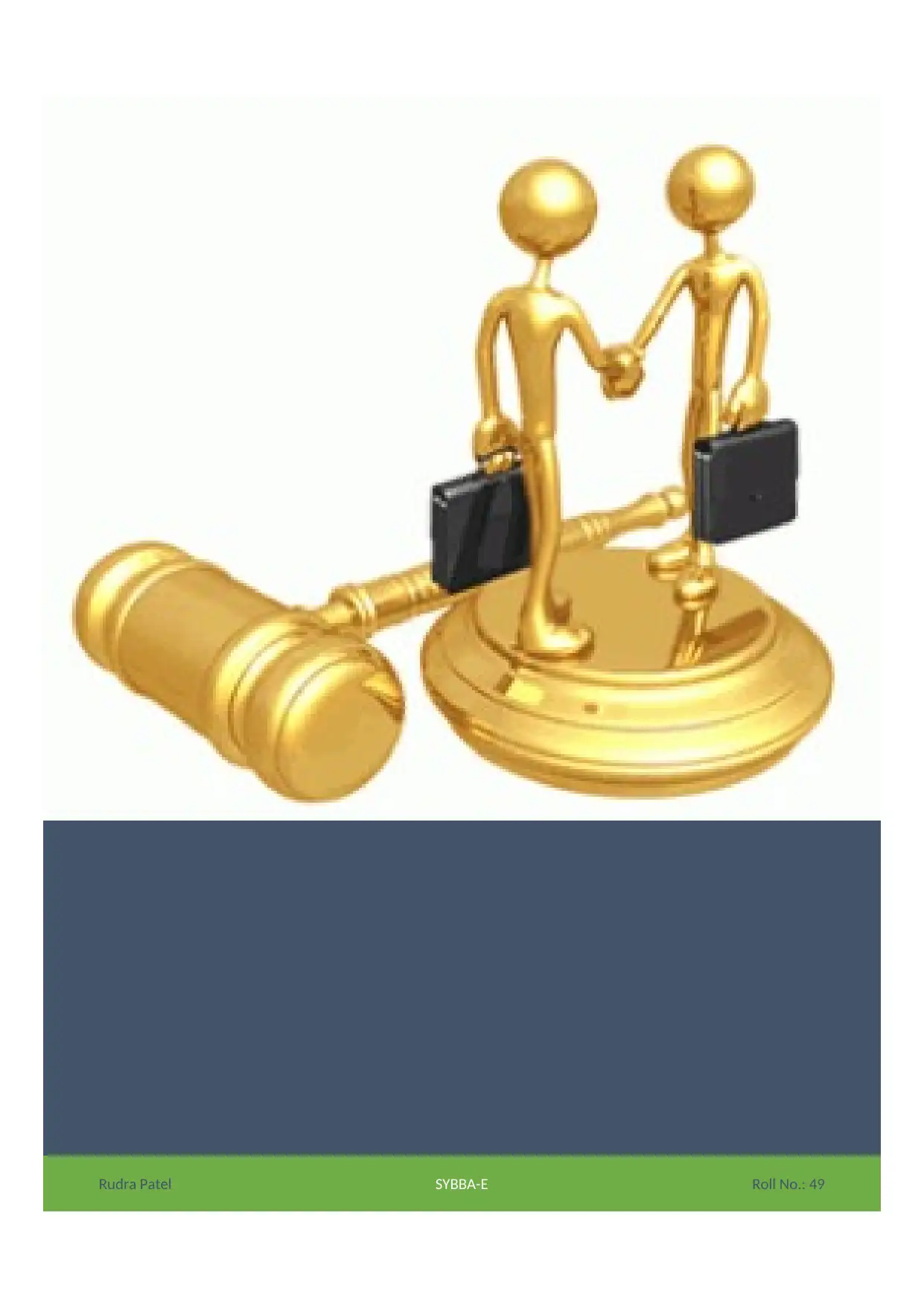
Business Law
Company- Essential Elements
Rudra Patel SYBBA-E Roll No.: 49
Company- Essential Elements
Rudra Patel SYBBA-E Roll No.: 49
Paraphrase This Document
Need a fresh take? Get an instant paraphrase of this document with our AI Paraphraser
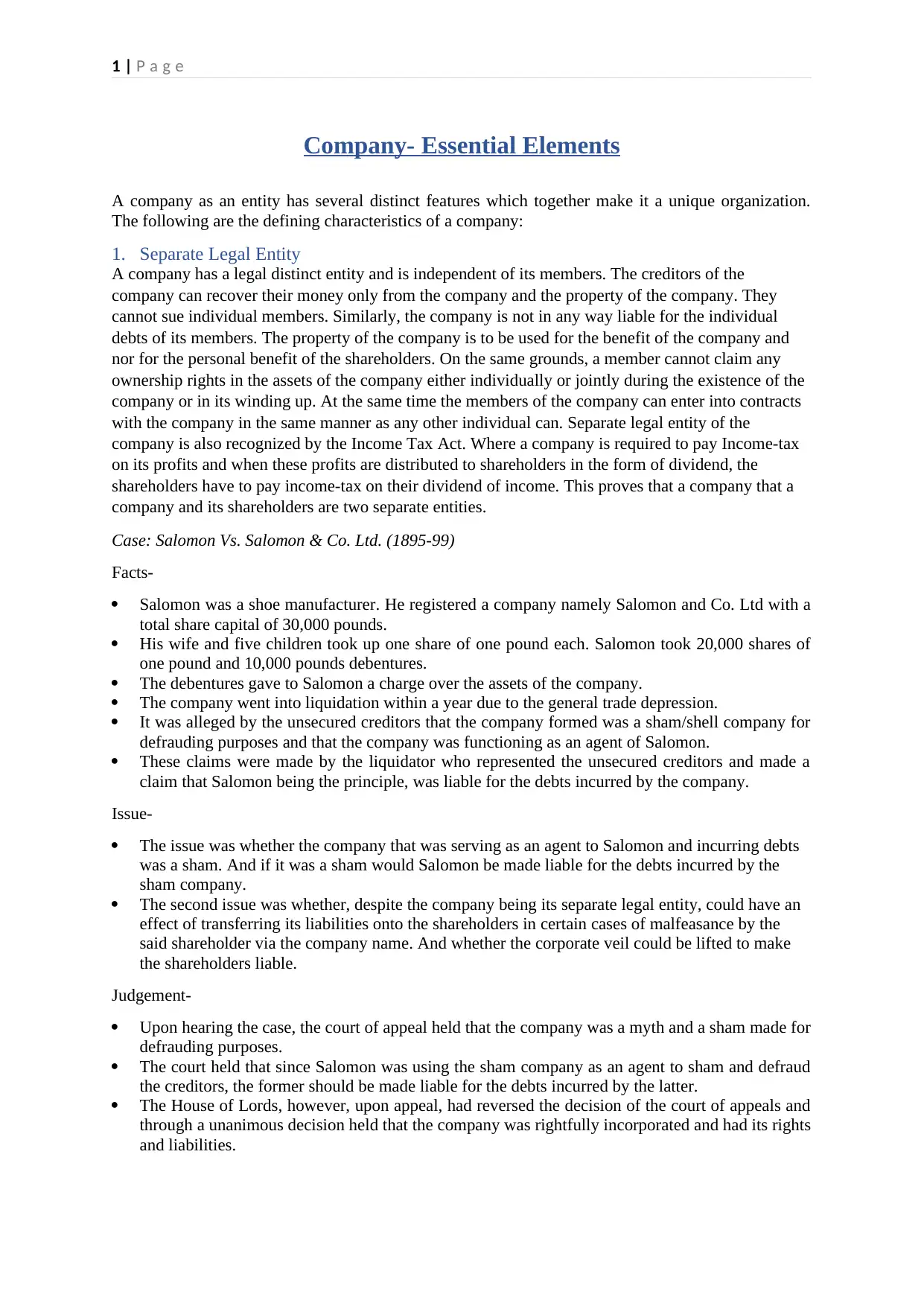
1 | P a g e
Company- Essential Elements
A company as an entity has several distinct features which together make it a unique organization.
The following are the defining characteristics of a company:
1. Separate Legal Entity
A company has a legal distinct entity and is independent of its members. The creditors of the
company can recover their money only from the company and the property of the company. They
cannot sue individual members. Similarly, the company is not in any way liable for the individual
debts of its members. The property of the company is to be used for the benefit of the company and
nor for the personal benefit of the shareholders. On the same grounds, a member cannot claim any
ownership rights in the assets of the company either individually or jointly during the existence of the
company or in its winding up. At the same time the members of the company can enter into contracts
with the company in the same manner as any other individual can. Separate legal entity of the
company is also recognized by the Income Tax Act. Where a company is required to pay Income-tax
on its profits and when these profits are distributed to shareholders in the form of dividend, the
shareholders have to pay income-tax on their dividend of income. This proves that a company that a
company and its shareholders are two separate entities.
Case: Salomon Vs. Salomon & Co. Ltd. (1895-99)
Facts-
Salomon was a shoe manufacturer. He registered a company namely Salomon and Co. Ltd with a
total share capital of 30,000 pounds.
His wife and five children took up one share of one pound each. Salomon took 20,000 shares of
one pound and 10,000 pounds debentures.
The debentures gave to Salomon a charge over the assets of the company.
The company went into liquidation within a year due to the general trade depression.
It was alleged by the unsecured creditors that the company formed was a sham/shell company for
defrauding purposes and that the company was functioning as an agent of Salomon.
These claims were made by the liquidator who represented the unsecured creditors and made a
claim that Salomon being the principle, was liable for the debts incurred by the company.
Issue-
The issue was whether the company that was serving as an agent to Salomon and incurring debts
was a sham. And if it was a sham would Salomon be made liable for the debts incurred by the
sham company.
The second issue was whether, despite the company being its separate legal entity, could have an
effect of transferring its liabilities onto the shareholders in certain cases of malfeasance by the
said shareholder via the company name. And whether the corporate veil could be lifted to make
the shareholders liable.
Judgement-
Upon hearing the case, the court of appeal held that the company was a myth and a sham made for
defrauding purposes.
The court held that since Salomon was using the sham company as an agent to sham and defraud
the creditors, the former should be made liable for the debts incurred by the latter.
The House of Lords, however, upon appeal, had reversed the decision of the court of appeals and
through a unanimous decision held that the company was rightfully incorporated and had its rights
and liabilities.
Company- Essential Elements
A company as an entity has several distinct features which together make it a unique organization.
The following are the defining characteristics of a company:
1. Separate Legal Entity
A company has a legal distinct entity and is independent of its members. The creditors of the
company can recover their money only from the company and the property of the company. They
cannot sue individual members. Similarly, the company is not in any way liable for the individual
debts of its members. The property of the company is to be used for the benefit of the company and
nor for the personal benefit of the shareholders. On the same grounds, a member cannot claim any
ownership rights in the assets of the company either individually or jointly during the existence of the
company or in its winding up. At the same time the members of the company can enter into contracts
with the company in the same manner as any other individual can. Separate legal entity of the
company is also recognized by the Income Tax Act. Where a company is required to pay Income-tax
on its profits and when these profits are distributed to shareholders in the form of dividend, the
shareholders have to pay income-tax on their dividend of income. This proves that a company that a
company and its shareholders are two separate entities.
Case: Salomon Vs. Salomon & Co. Ltd. (1895-99)
Facts-
Salomon was a shoe manufacturer. He registered a company namely Salomon and Co. Ltd with a
total share capital of 30,000 pounds.
His wife and five children took up one share of one pound each. Salomon took 20,000 shares of
one pound and 10,000 pounds debentures.
The debentures gave to Salomon a charge over the assets of the company.
The company went into liquidation within a year due to the general trade depression.
It was alleged by the unsecured creditors that the company formed was a sham/shell company for
defrauding purposes and that the company was functioning as an agent of Salomon.
These claims were made by the liquidator who represented the unsecured creditors and made a
claim that Salomon being the principle, was liable for the debts incurred by the company.
Issue-
The issue was whether the company that was serving as an agent to Salomon and incurring debts
was a sham. And if it was a sham would Salomon be made liable for the debts incurred by the
sham company.
The second issue was whether, despite the company being its separate legal entity, could have an
effect of transferring its liabilities onto the shareholders in certain cases of malfeasance by the
said shareholder via the company name. And whether the corporate veil could be lifted to make
the shareholders liable.
Judgement-
Upon hearing the case, the court of appeal held that the company was a myth and a sham made for
defrauding purposes.
The court held that since Salomon was using the sham company as an agent to sham and defraud
the creditors, the former should be made liable for the debts incurred by the latter.
The House of Lords, however, upon appeal, had reversed the decision of the court of appeals and
through a unanimous decision held that the company was rightfully incorporated and had its rights
and liabilities.
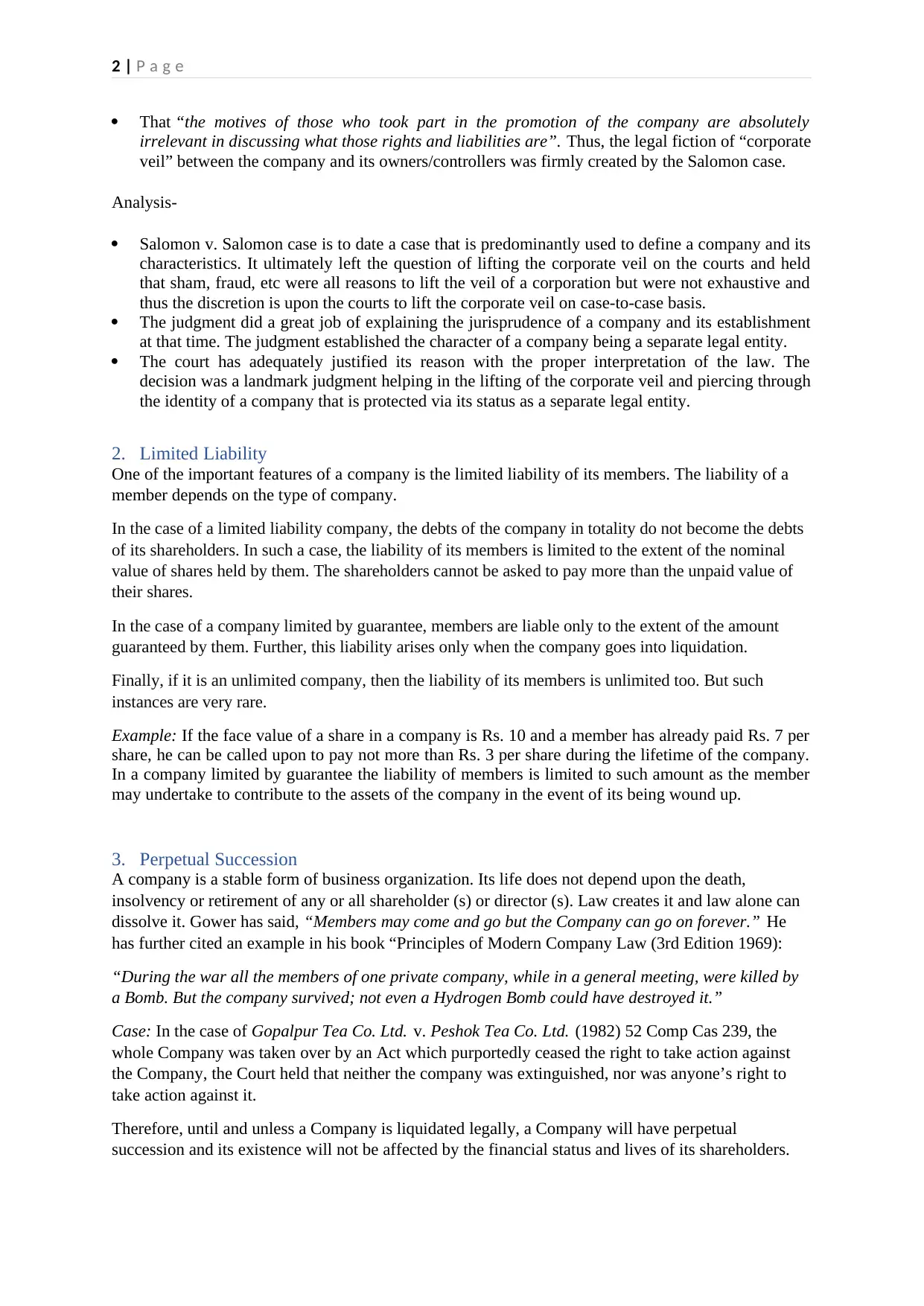
2 | P a g e
That “the motives of those who took part in the promotion of the company are absolutely
irrelevant in discussing what those rights and liabilities are”. Thus, the legal fiction of “corporate
veil” between the company and its owners/controllers was firmly created by the Salomon case.
Analysis-
Salomon v. Salomon case is to date a case that is predominantly used to define a company and its
characteristics. It ultimately left the question of lifting the corporate veil on the courts and held
that sham, fraud, etc were all reasons to lift the veil of a corporation but were not exhaustive and
thus the discretion is upon the courts to lift the corporate veil on case-to-case basis.
The judgment did a great job of explaining the jurisprudence of a company and its establishment
at that time. The judgment established the character of a company being a separate legal entity.
The court has adequately justified its reason with the proper interpretation of the law. The
decision was a landmark judgment helping in the lifting of the corporate veil and piercing through
the identity of a company that is protected via its status as a separate legal entity.
2. Limited Liability
One of the important features of a company is the limited liability of its members. The liability of a
member depends on the type of company.
In the case of a limited liability company, the debts of the company in totality do not become the debts
of its shareholders. In such a case, the liability of its members is limited to the extent of the nominal
value of shares held by them. The shareholders cannot be asked to pay more than the unpaid value of
their shares.
In the case of a company limited by guarantee, members are liable only to the extent of the amount
guaranteed by them. Further, this liability arises only when the company goes into liquidation.
Finally, if it is an unlimited company, then the liability of its members is unlimited too. But such
instances are very rare.
Example: If the face value of a share in a company is Rs. 10 and a member has already paid Rs. 7 per
share, he can be called upon to pay not more than Rs. 3 per share during the lifetime of the company.
In a company limited by guarantee the liability of members is limited to such amount as the member
may undertake to contribute to the assets of the company in the event of its being wound up.
3. Perpetual Succession
A company is a stable form of business organization. Its life does not depend upon the death,
insolvency or retirement of any or all shareholder (s) or director (s). Law creates it and law alone can
dissolve it. Gower has said, “Members may come and go but the Company can go on forever.” He
has further cited an example in his book “Principles of Modern Company Law (3rd Edition 1969):
“During the war all the members of one private company, while in a general meeting, were killed by
a Bomb. But the company survived; not even a Hydrogen Bomb could have destroyed it.”
Case: In the case of Gopalpur Tea Co. Ltd. v. Peshok Tea Co. Ltd. (1982) 52 Comp Cas 239, the
whole Company was taken over by an Act which purportedly ceased the right to take action against
the Company, the Court held that neither the company was extinguished, nor was anyone’s right to
take action against it.
Therefore, until and unless a Company is liquidated legally, a Company will have perpetual
succession and its existence will not be affected by the financial status and lives of its shareholders.
That “the motives of those who took part in the promotion of the company are absolutely
irrelevant in discussing what those rights and liabilities are”. Thus, the legal fiction of “corporate
veil” between the company and its owners/controllers was firmly created by the Salomon case.
Analysis-
Salomon v. Salomon case is to date a case that is predominantly used to define a company and its
characteristics. It ultimately left the question of lifting the corporate veil on the courts and held
that sham, fraud, etc were all reasons to lift the veil of a corporation but were not exhaustive and
thus the discretion is upon the courts to lift the corporate veil on case-to-case basis.
The judgment did a great job of explaining the jurisprudence of a company and its establishment
at that time. The judgment established the character of a company being a separate legal entity.
The court has adequately justified its reason with the proper interpretation of the law. The
decision was a landmark judgment helping in the lifting of the corporate veil and piercing through
the identity of a company that is protected via its status as a separate legal entity.
2. Limited Liability
One of the important features of a company is the limited liability of its members. The liability of a
member depends on the type of company.
In the case of a limited liability company, the debts of the company in totality do not become the debts
of its shareholders. In such a case, the liability of its members is limited to the extent of the nominal
value of shares held by them. The shareholders cannot be asked to pay more than the unpaid value of
their shares.
In the case of a company limited by guarantee, members are liable only to the extent of the amount
guaranteed by them. Further, this liability arises only when the company goes into liquidation.
Finally, if it is an unlimited company, then the liability of its members is unlimited too. But such
instances are very rare.
Example: If the face value of a share in a company is Rs. 10 and a member has already paid Rs. 7 per
share, he can be called upon to pay not more than Rs. 3 per share during the lifetime of the company.
In a company limited by guarantee the liability of members is limited to such amount as the member
may undertake to contribute to the assets of the company in the event of its being wound up.
3. Perpetual Succession
A company is a stable form of business organization. Its life does not depend upon the death,
insolvency or retirement of any or all shareholder (s) or director (s). Law creates it and law alone can
dissolve it. Gower has said, “Members may come and go but the Company can go on forever.” He
has further cited an example in his book “Principles of Modern Company Law (3rd Edition 1969):
“During the war all the members of one private company, while in a general meeting, were killed by
a Bomb. But the company survived; not even a Hydrogen Bomb could have destroyed it.”
Case: In the case of Gopalpur Tea Co. Ltd. v. Peshok Tea Co. Ltd. (1982) 52 Comp Cas 239, the
whole Company was taken over by an Act which purportedly ceased the right to take action against
the Company, the Court held that neither the company was extinguished, nor was anyone’s right to
take action against it.
Therefore, until and unless a Company is liquidated legally, a Company will have perpetual
succession and its existence will not be affected by the financial status and lives of its shareholders.
⊘ This is a preview!⊘
Do you want full access?
Subscribe today to unlock all pages.

Trusted by 1+ million students worldwide
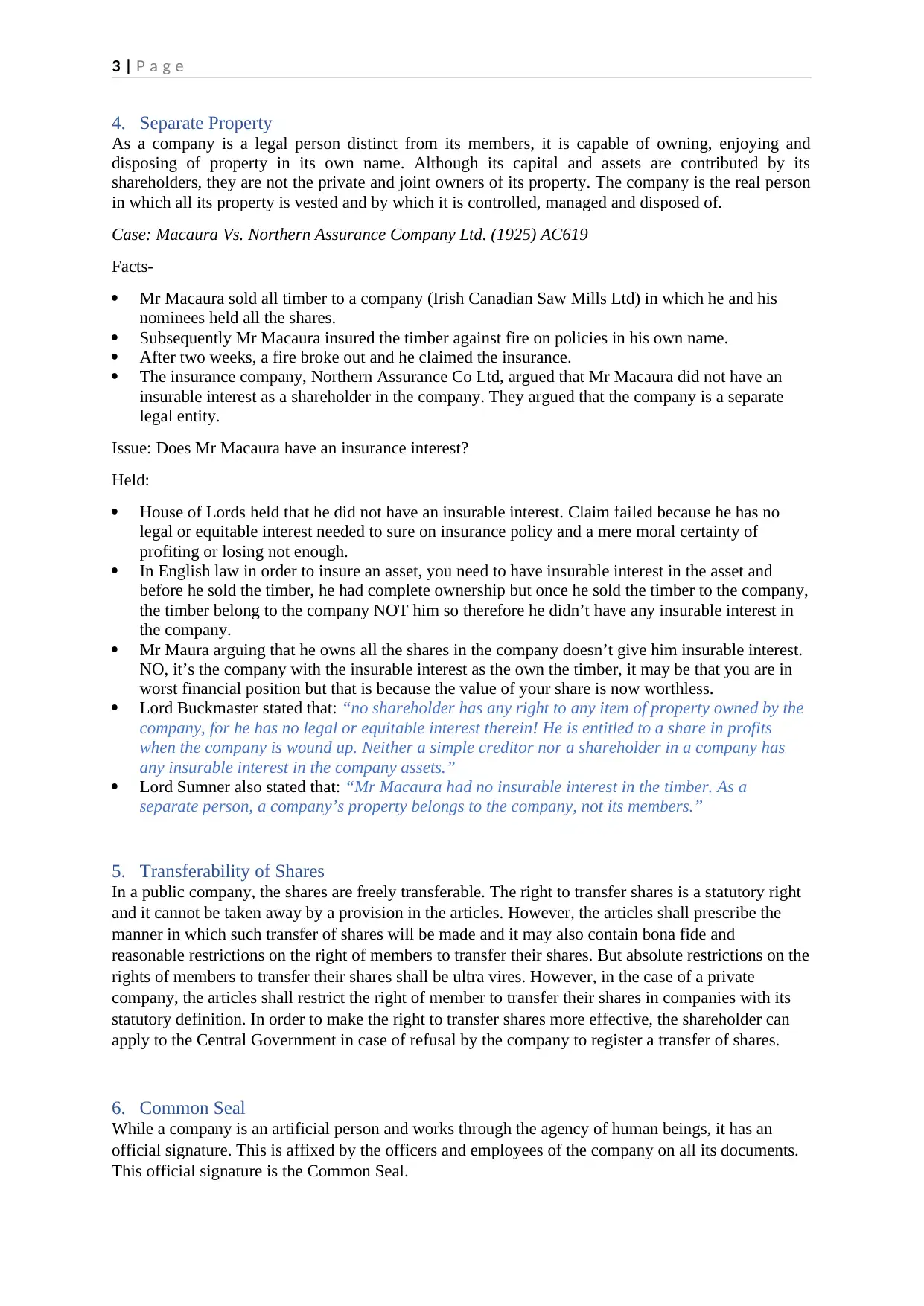
3 | P a g e
4. Separate Property
As a company is a legal person distinct from its members, it is capable of owning, enjoying and
disposing of property in its own name. Although its capital and assets are contributed by its
shareholders, they are not the private and joint owners of its property. The company is the real person
in which all its property is vested and by which it is controlled, managed and disposed of.
Case: Macaura Vs. Northern Assurance Company Ltd. (1925) AC619
Facts-
Mr Macaura sold all timber to a company (Irish Canadian Saw Mills Ltd) in which he and his
nominees held all the shares.
Subsequently Mr Macaura insured the timber against fire on policies in his own name.
After two weeks, a fire broke out and he claimed the insurance.
The insurance company, Northern Assurance Co Ltd, argued that Mr Macaura did not have an
insurable interest as a shareholder in the company. They argued that the company is a separate
legal entity.
Issue: Does Mr Macaura have an insurance interest?
Held:
House of Lords held that he did not have an insurable interest. Claim failed because he has no
legal or equitable interest needed to sure on insurance policy and a mere moral certainty of
profiting or losing not enough.
In English law in order to insure an asset, you need to have insurable interest in the asset and
before he sold the timber, he had complete ownership but once he sold the timber to the company,
the timber belong to the company NOT him so therefore he didn’t have any insurable interest in
the company.
Mr Maura arguing that he owns all the shares in the company doesn’t give him insurable interest.
NO, it’s the company with the insurable interest as the own the timber, it may be that you are in
worst financial position but that is because the value of your share is now worthless.
Lord Buckmaster stated that: “no shareholder has any right to any item of property owned by the
company, for he has no legal or equitable interest therein! He is entitled to a share in profits
when the company is wound up. Neither a simple creditor nor a shareholder in a company has
any insurable interest in the company assets.”
Lord Sumner also stated that: “Mr Macaura had no insurable interest in the timber. As a
separate person, a company’s property belongs to the company, not its members.”
5. Transferability of Shares
In a public company, the shares are freely transferable. The right to transfer shares is a statutory right
and it cannot be taken away by a provision in the articles. However, the articles shall prescribe the
manner in which such transfer of shares will be made and it may also contain bona fide and
reasonable restrictions on the right of members to transfer their shares. But absolute restrictions on the
rights of members to transfer their shares shall be ultra vires. However, in the case of a private
company, the articles shall restrict the right of member to transfer their shares in companies with its
statutory definition. In order to make the right to transfer shares more effective, the shareholder can
apply to the Central Government in case of refusal by the company to register a transfer of shares.
6. Common Seal
While a company is an artificial person and works through the agency of human beings, it has an
official signature. This is affixed by the officers and employees of the company on all its documents.
This official signature is the Common Seal.
4. Separate Property
As a company is a legal person distinct from its members, it is capable of owning, enjoying and
disposing of property in its own name. Although its capital and assets are contributed by its
shareholders, they are not the private and joint owners of its property. The company is the real person
in which all its property is vested and by which it is controlled, managed and disposed of.
Case: Macaura Vs. Northern Assurance Company Ltd. (1925) AC619
Facts-
Mr Macaura sold all timber to a company (Irish Canadian Saw Mills Ltd) in which he and his
nominees held all the shares.
Subsequently Mr Macaura insured the timber against fire on policies in his own name.
After two weeks, a fire broke out and he claimed the insurance.
The insurance company, Northern Assurance Co Ltd, argued that Mr Macaura did not have an
insurable interest as a shareholder in the company. They argued that the company is a separate
legal entity.
Issue: Does Mr Macaura have an insurance interest?
Held:
House of Lords held that he did not have an insurable interest. Claim failed because he has no
legal or equitable interest needed to sure on insurance policy and a mere moral certainty of
profiting or losing not enough.
In English law in order to insure an asset, you need to have insurable interest in the asset and
before he sold the timber, he had complete ownership but once he sold the timber to the company,
the timber belong to the company NOT him so therefore he didn’t have any insurable interest in
the company.
Mr Maura arguing that he owns all the shares in the company doesn’t give him insurable interest.
NO, it’s the company with the insurable interest as the own the timber, it may be that you are in
worst financial position but that is because the value of your share is now worthless.
Lord Buckmaster stated that: “no shareholder has any right to any item of property owned by the
company, for he has no legal or equitable interest therein! He is entitled to a share in profits
when the company is wound up. Neither a simple creditor nor a shareholder in a company has
any insurable interest in the company assets.”
Lord Sumner also stated that: “Mr Macaura had no insurable interest in the timber. As a
separate person, a company’s property belongs to the company, not its members.”
5. Transferability of Shares
In a public company, the shares are freely transferable. The right to transfer shares is a statutory right
and it cannot be taken away by a provision in the articles. However, the articles shall prescribe the
manner in which such transfer of shares will be made and it may also contain bona fide and
reasonable restrictions on the right of members to transfer their shares. But absolute restrictions on the
rights of members to transfer their shares shall be ultra vires. However, in the case of a private
company, the articles shall restrict the right of member to transfer their shares in companies with its
statutory definition. In order to make the right to transfer shares more effective, the shareholder can
apply to the Central Government in case of refusal by the company to register a transfer of shares.
6. Common Seal
While a company is an artificial person and works through the agency of human beings, it has an
official signature. This is affixed by the officers and employees of the company on all its documents.
This official signature is the Common Seal.
Paraphrase This Document
Need a fresh take? Get an instant paraphrase of this document with our AI Paraphraser
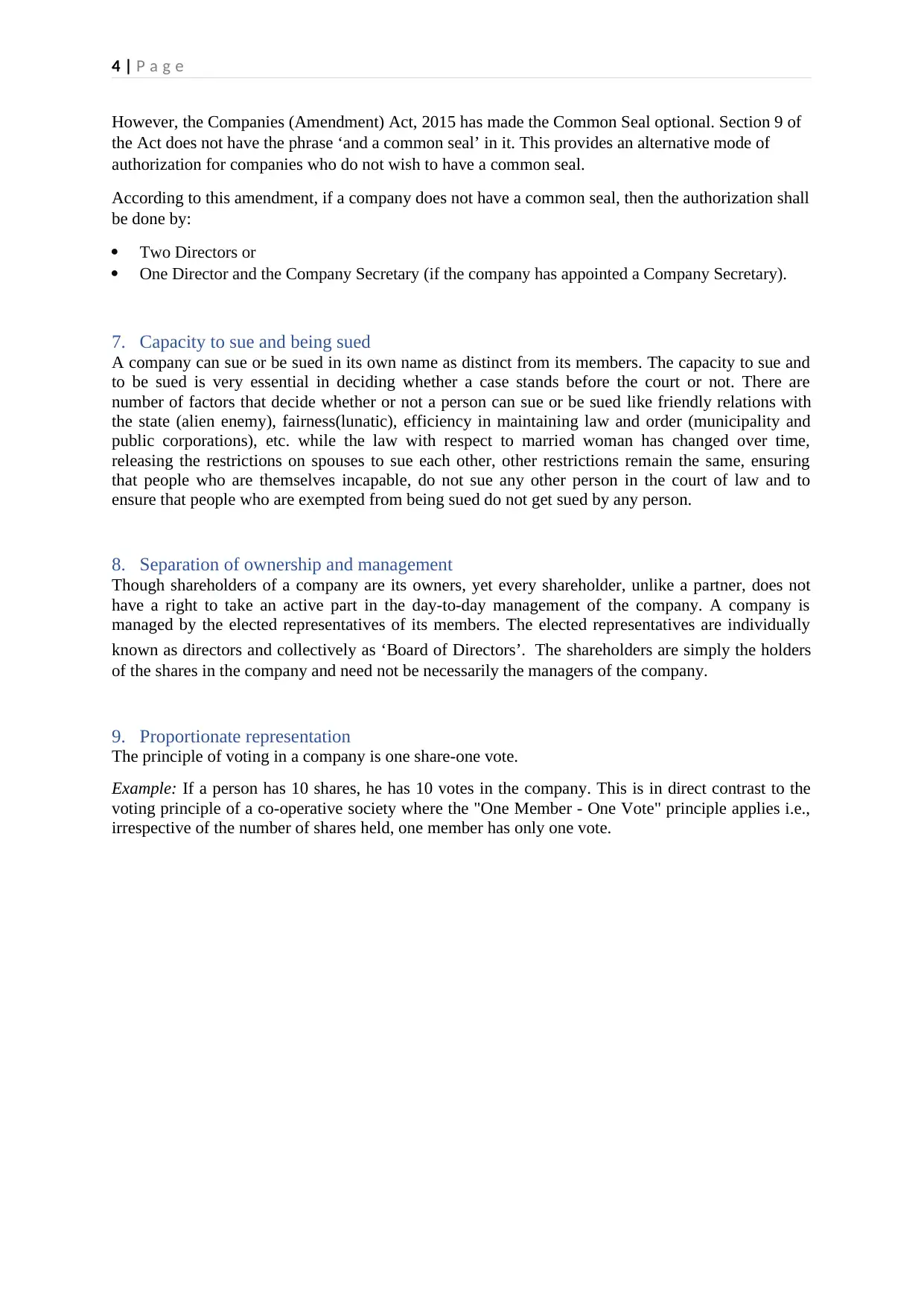
4 | P a g e
However, the Companies (Amendment) Act, 2015 has made the Common Seal optional. Section 9 of
the Act does not have the phrase ‘and a common seal’ in it. This provides an alternative mode of
authorization for companies who do not wish to have a common seal.
According to this amendment, if a company does not have a common seal, then the authorization shall
be done by:
Two Directors or
One Director and the Company Secretary (if the company has appointed a Company Secretary).
7. Capacity to sue and being sued
A company can sue or be sued in its own name as distinct from its members. The capacity to sue and
to be sued is very essential in deciding whether a case stands before the court or not. There are
number of factors that decide whether or not a person can sue or be sued like friendly relations with
the state (alien enemy), fairness(lunatic), efficiency in maintaining law and order (municipality and
public corporations), etc. while the law with respect to married woman has changed over time,
releasing the restrictions on spouses to sue each other, other restrictions remain the same, ensuring
that people who are themselves incapable, do not sue any other person in the court of law and to
ensure that people who are exempted from being sued do not get sued by any person.
8. Separation of ownership and management
Though shareholders of a company are its owners, yet every shareholder, unlike a partner, does not
have a right to take an active part in the day-to-day management of the company. A company is
managed by the elected representatives of its members. The elected representatives are individually
known as directors and collectively as ‘Board of Directors’. The shareholders are simply the holders
of the shares in the company and need not be necessarily the managers of the company.
9. Proportionate representation
The principle of voting in a company is one share-one vote.
Example: If a person has 10 shares, he has 10 votes in the company. This is in direct contrast to the
voting principle of a co-operative society where the "One Member - One Vote" principle applies i.e.,
irrespective of the number of shares held, one member has only one vote.
However, the Companies (Amendment) Act, 2015 has made the Common Seal optional. Section 9 of
the Act does not have the phrase ‘and a common seal’ in it. This provides an alternative mode of
authorization for companies who do not wish to have a common seal.
According to this amendment, if a company does not have a common seal, then the authorization shall
be done by:
Two Directors or
One Director and the Company Secretary (if the company has appointed a Company Secretary).
7. Capacity to sue and being sued
A company can sue or be sued in its own name as distinct from its members. The capacity to sue and
to be sued is very essential in deciding whether a case stands before the court or not. There are
number of factors that decide whether or not a person can sue or be sued like friendly relations with
the state (alien enemy), fairness(lunatic), efficiency in maintaining law and order (municipality and
public corporations), etc. while the law with respect to married woman has changed over time,
releasing the restrictions on spouses to sue each other, other restrictions remain the same, ensuring
that people who are themselves incapable, do not sue any other person in the court of law and to
ensure that people who are exempted from being sued do not get sued by any person.
8. Separation of ownership and management
Though shareholders of a company are its owners, yet every shareholder, unlike a partner, does not
have a right to take an active part in the day-to-day management of the company. A company is
managed by the elected representatives of its members. The elected representatives are individually
known as directors and collectively as ‘Board of Directors’. The shareholders are simply the holders
of the shares in the company and need not be necessarily the managers of the company.
9. Proportionate representation
The principle of voting in a company is one share-one vote.
Example: If a person has 10 shares, he has 10 votes in the company. This is in direct contrast to the
voting principle of a co-operative society where the "One Member - One Vote" principle applies i.e.,
irrespective of the number of shares held, one member has only one vote.
1 out of 5
Related Documents
Your All-in-One AI-Powered Toolkit for Academic Success.
+13062052269
info@desklib.com
Available 24*7 on WhatsApp / Email
![[object Object]](/_next/static/media/star-bottom.7253800d.svg)
Unlock your academic potential
Copyright © 2020–2025 A2Z Services. All Rights Reserved. Developed and managed by ZUCOL.





